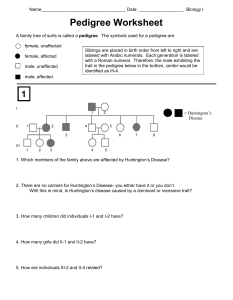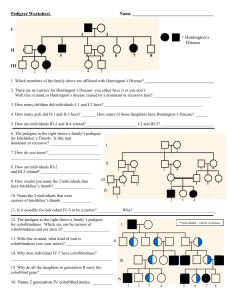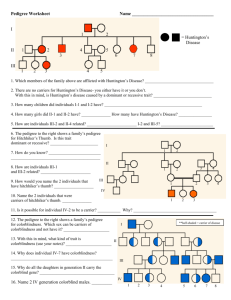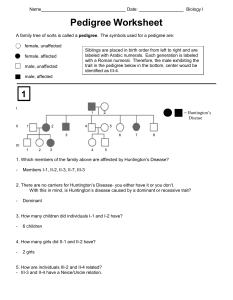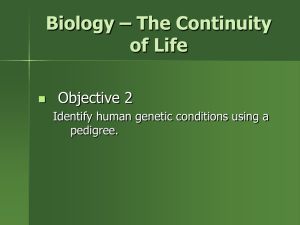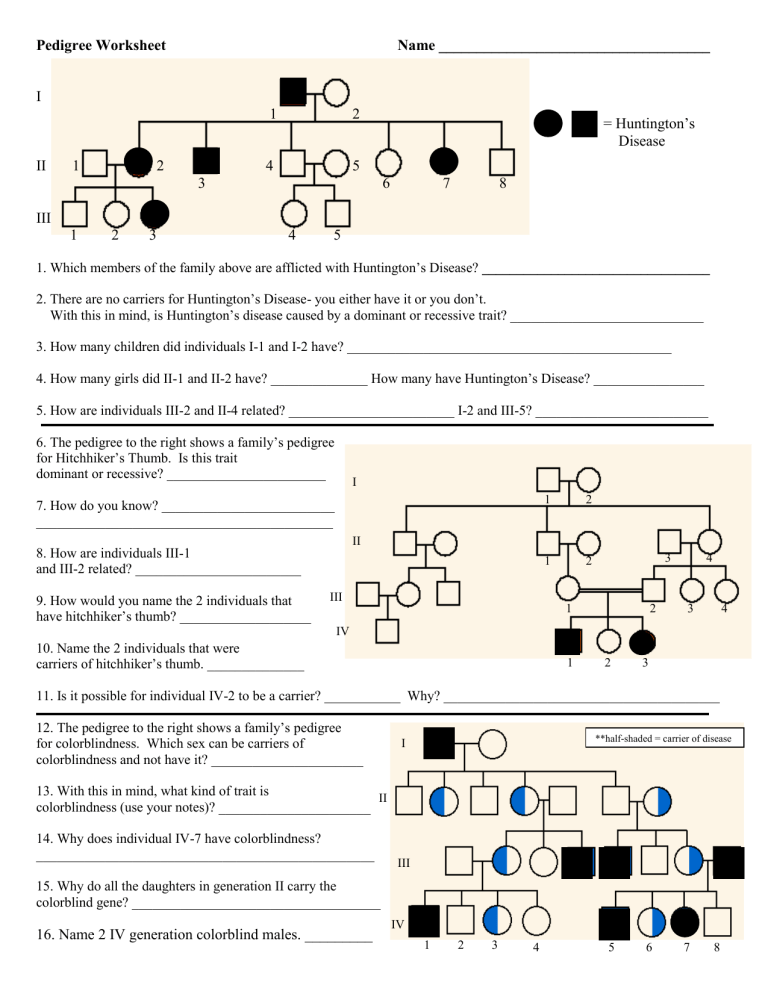
Pedigree Worksheet Name ____________________________________ I II 1 2 1 2 4 5 3 = Huntington’s Disease 6 7 8 III 1 2 3 4 5 1. Which members of the family above are afflicted with Huntington’s Disease? _________________________________ 2. There are no carriers for Huntington’s Disease- you either have it or you don’t. With this in mind, is Huntington’s disease caused by a dominant or recessive trait? ____________________________ 3. How many children did individuals I-1 and I-2 have? _______________________________________________ 4. How many girls did II-1 and II-2 have? ______________ How many have Huntington’s Disease? ________________ 5. How are individuals III-2 and II-4 related? ________________________ I-2 and III-5? _________________________ 6. The pedigree to the right shows a family’s pedigree for Hitchhiker’s Thumb. Is this trait dominant or recessive? _______________________ I 7. How do you know? _________________________ ___________________________________________ 1 2 1 2 II 8. How are individuals III-1 and III-2 related? ________________________ 9. How would you name the 2 individuals that have hitchhiker’s thumb? ___________________ 3 4 III 1 2 3 4 IV 10. Name the 2 individuals that were carriers of hitchhiker’s thumb. ______________ 1 2 3 11. Is it possible for individual IV-2 to be a carrier? ___________ Why? ________________________________________ 12. The pedigree to the right shows a family’s pedigree for colorblindness. Which sex can be carriers of colorblindness and not have it? ______________________ **half-shaded = carrier of disease I 13. With this in mind, what kind of trait is II colorblindness (use your notes)? ______________________ 14. Why does individual IV-7 have colorblindness? _________________________________________________ III 15. Why do all the daughters in generation II carry the colorblind gene? ____________________________________ 16. Name 2 IV generation colorblind males. _________ IV 1 2 3 4 5 6 7 8 Name ____________________________________ Genetics Pedigree Worksheet A pedigree is a chart of a person’s ancestors that is used to analyze genetic inheritance of certain traits – especially diseases. The symbols used for a pedigree are: female, unaffected male, unaffected female, affected male, affected Siblings are placed in birth order from left to right and are labeled with numbers. Each generation is labeled with a Roman numeral. o Example: we would name an individual II-3 if he/she was in the second generation and the 3rd child born ------------------------------------------------ -----------------------------I 1 2 3 4 5 6 II 1 2 3 4 5 6 7 8 9 III 1 2 3 4 5 6 7 8 Try to identify the genotypes of the following individuals using the pedigree above. (homozygous dominant, homozygous recessive, heterozygous) III-3: ___________________________________ I-1: ____________________________________ II-1: ____________________________________ II-4: ____________________________________ 1. Is this trait dominant or recessive? Explain your answer. ___________________________________________________________________________________________ ___________________________________________________________________________________________ ___________________________________________________________________________________________ 2. How can you know for sure that individuals II-3 and II-4 are heterozygous? ___________________________________________________________________________________________ ___________________________________________________________________________________________ 3. Brown eyes are a dominant eye-color allele and blue eyes are recessive. A brown-eyed woman whose father had blue eyes and whose mother had brown eyes marries a brown-eyed man whose parents are also brown-eyed. They have a son who is blue-eyed. Please draw a pedigree showing all four grandparents, the two parents, and the son. Indicate which individuals you are certain of their genotype and where there are more than one possibilities. Pedigree Worksheet KEY I II 1 2 1 2 4 5 3 = Huntington’s Disease 6 7 8 III 1 2 3 4 5 1. Which members of the family above are afflicted with Huntington’s Disease? I1, II2, II3, II7, III3 2. There are no carriers for Huntington’s Disease- you either have it or you don’t. With this in mind, is Huntington’s disease caused by a dominant or recessive trait? Dominant 3. How many children did individuals I-1 and I-2 have? 6 4. How many girls did II-1 and II-2 have? 2 How many have Huntington’s Disease? 1 or 5 5. How are individuals III-2 and II-4 related? Uncle/Niece I-2 and III-5? Grandma/Grandson 6. The pedigree to the right shows a family’s pedigree for Hitchhiker’s Thumb. Is this trait dominant or recessive? Recessive I 7. How do you know? III1 and III2 do not have it but their children do. 1 2 1 2 II 8. How are individuals III-1 and III-2 related? Cousins/Marriage 9. How would you name the 2 individuals that have hitchhiker’s thumb? IV1 and IV3 3 4 III 1 2 3 4 IV 10. Name the 2 individuals that were carriers of hitchhiker’s thumb. III1 and III2 1 2 3 11. Is it possible for individual IV-2 to be a carrier? Yes Why? b/c parents were heterozygous 12. The pedigree to the right shows a family’s pedigree for colorblindness. Which sex can be carriers of colorblindness and not have it? Females 13. With this in mind, what kind of trait is colorblindness (use your notes)? Sexlinked/recessive **half-shaded = carrier of disease I II 14. Why does individual IV-7 have colorblindness? b/c mom was a carrier and dad was affected III 15. Why do all the daughters in generation II carry the colorblind gene? b/c dad was affected and its on the X 16. Name 2 IV generation colorblind males. IV1, IV5 IV 1 2 3 4 5 6 7 8 Pedigree Worksheet KEY Genetics Pedigree Worksheet A pedigree is a chart of a person’s ancestors that is used to analyze genetic inheritance of certain traits – especially diseases. The symbols used for a pedigree are: female, unaffected male, unaffected female, affected male, affected Siblings are placed in birth order from left to right and are labeled with numbers. Each generation is labeled with a Roman numeral. o Example: we would name an individual II-3 if he/she was in the second generation and the 3rd child born ------------------------------------------------ -----------------------------I 1 2 3 4 5 6 II 1 2 3 4 5 6 7 8 9 III 1 2 3 4 5 6 7 8 Try to identify the genotypes of the following individuals using the pedigree above. (homozygous dominant, homozygous recessive, heterozygous) III-3: Homozygous recessive I-1: Homozygous recessive II-1: Heterozygous II-4: Heterozygous 1. Is this trait dominant or recessive? Explain your answer. It is a recessive trait because generation II does not have the disease and Generations I and II do have it. 2. How can you know for sure that individuals II-3 and II-4 are heterozygous? Because their offspring have the disease so they are both carriers of it. 3. Brown eyes are a dominant eye-color allele and blue eyes are recessive. A brown-eyed woman whose father had blue eyes and whose mother had brown eyes marries a brown-eyed man whose parents are also brown-eyed. They have a son who is blue-eyed. Please draw a pedigree showing all four grandparents, the two parents, and the son. Indicate which individuals you are certain of their genotype and where there are more than one possibilities.
